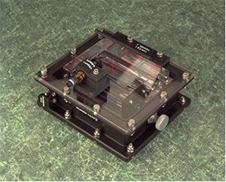September 29, 2009 Vol. 2, Issue 9
The age of the medieval guilds may be long gone, but their legacy remains with us.
A few years ago I was talking to a project manager at Glenn Research Center who was describing the work of machinists at Glenn who built glove box experiments for NASA’s microgravity program. “These were so intricate that they were almost like artistic creations,” he said. He was paying tribute to the importance of craft. The ability to make things—to turn raw materials into hardware—is an enduring source of pride at NASA.

A microgravity glovebox built at Glenn Research Center was used in the Interface Configuration Experiment that flew on Space Shuttle mission STS-73 in 1995.
While few in number, NASA has always had craft workers among its ranks. It is part of the legacy that NASA inherited from the National Advisory Committee for Aeronautics (NACA), its predecessor organization. In his book Inside NASA, a seminal study of NASA’s early culture, Professor Howard McCurdy quoted a Langley engineer from the NACA days talking about the craft culture of that era: “We had our own sheet metal machine shop, plastics, wood shops. We could build anything there provided it wasn’t too big.”
The emphasis on hands-on work has remained part of NASA’s culture, and the prospect of making things with one’s hands still stirs a sense of pride — of building something from nothing — deep within us. Engineers often share stories in the Academy’s Masters Forum or case studies about hand-building prototypes or test models, and as they talk about this work they grow visibly excited about their creations. While model building should not be confused with the work of master craftsmen, it speaks to the importance that NASA engineers place on remaining close to the hardware.
One of the roles of guilds in earlier times was to establish quality standards for craftsmanship. An individual became a master craftsman by creating a masterpiece that other masters in the guild deemed worthy of recognition. Guild members worked their way up to attain different levels of mastery — apprentice, craftsman, journeyman, master craftsman, and grand master — throughout their careers.
There are several legacies of craft culture that touch every technical worker at NASA. Our technical standards and procedures reflect the experience and wisdom of the international guild of aerospace technical workers—what we have learned within NASA as well as from partners in other government agencies, industry, and academia. The Academy’s four-level professional development framework, which spans from “fresh-out” to executive, is a direct descendant of the levels of mastery established by the guilds. Our knowledge sharing activities help to create a community of practitioners, which was the essence of a guild. Through our Masters Forums, we recognize and celebrate mastery within our culture.
A respect for the importance of craft is in NASA’s organizational DNA. Even as our systems become increasingly complex and defined by a breathtaking degree of precision, there will still always be individuals in our workshops and laboratories to refine an existing technology or build something altogether new. This relentless engineering curiosity is central to our core values of excellence and mission success, and it depends on our sustained ability to integrate the skills of craftsmen with the reality of the twenty-first century.





